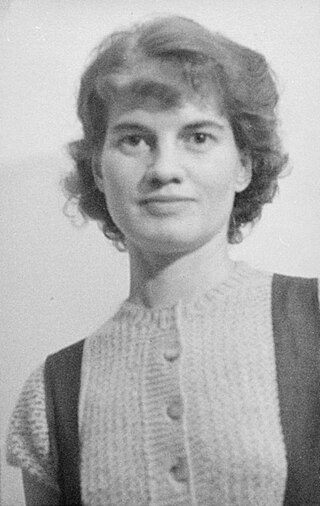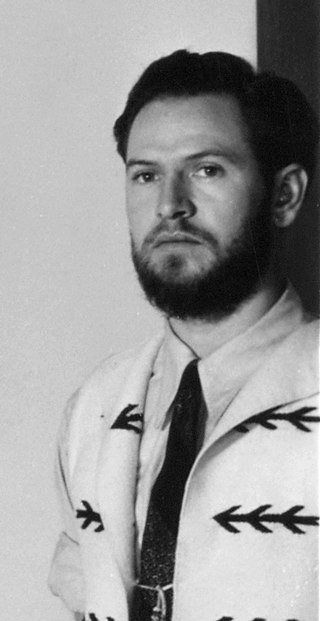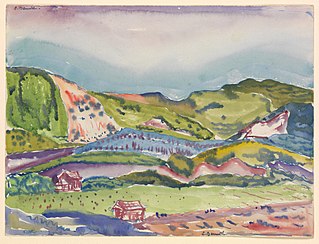
Anna Mary Robertson Moses, or Grandma Moses, was an American folk artist. She began painting in earnest at the age of 78 and is a prominent example of a newly successful art career at an advanced age. Moses gained popularity during the 1950s, having been featured on a cover of Time Magazine in 1953, was a subject of numerous television programs and of a 1950 Oscar-nominated biographical documentary. Her autobiography, titled My Life's History, was published in 1952. She was also awarded two honorary doctoral degrees.

Charles Henry Buckius Demuth was an American painter who specialized in watercolors and turned to oils late in his career, developing a style of painting known as Precisionism.

Precisionism was a modernist art movement that emerged in the United States after World War I. Influenced by Cubism, Purism, and Futurism, Precisionist artists reduced subjects to their essential geometric shapes, eliminated detail, and often used planes of light to create a sense of crisp focus and suggest the sleekness and sheen of machine forms. At the height of its popularity during the 1920s and early 1930s, Precisionism celebrated the new American landscape of skyscrapers, bridges, and factories in a form that has also been called "Cubist-Realism." The term "Precisionism" was first coined in the mid-1920s, possibly by Museum of Modern Art director Alfred H. Barr although according to Amy Dempsey the term "Precisionism" was coined by Charles Sheeler. Painters working in this style were also known as the "Immaculates", which was the more commonly used term at the time. The stiffness of both art-historical labels suggests the difficulties contemporary critics had in attempting to characterize these artists.

Marsden Hartley was an American Modernist painter, poet, and essayist. Hartley developed his painting abilities by observing Cubist artists in Paris and Berlin.

View of Toledo, is one of the two surviving landscapes painted by El Greco, along with View and Plan of Toledo. View of Toledo is held by the Metropolitan Museum of Art in New York City.

Elsie Driggs was an American painter known for her contributions to Precisionism, America's one indigenous modern-art movement before Abstract Expressionism, and for her later floral and figurative watercolors, pastels, and oils. She was the only female participant in the Precisionist movement, which in the 1920s and 1930s took a Cubist-inspired approach to painting the skyscrapers and factories that had come to define the new American landscape. Her works are in the collection of the Whitney Museum of American Art, the Houston Museum of the Fine Arts, the Fine Arts Museums of San Francisco, the James A. Michener Art Museum in Pennsylvania, and the Columbus Museum of Art, among others. She was married to the American abstract artist Lee Gatch.

The Flight into Egypt is an oil-on-copper cabinet painting by the German artist Adam Elsheimer dating from about 1609, while he was in Rome. It is thought to be the first naturalistic rendering of the night sky in Renaissance art. At Elsheimer's death in Rome in 1610, this picture was hanging in his bedroom. Like many other artists before and after him, Elsheimer has depicted the biblical Flight into Egypt, in which Joseph, Mary, and Jesus seek refuge from possible persecution by Herod. For its innovative fusing of religious and landscape elements, and its detailed juxtaposition of light and darkness, The Flight into Egypt is one of Elsheimer's most well-known and lauded works. It is also likely his last painting, for he died a year later.

Hotel Lobby is a 1943 oil painting on canvas by American realist painter Edward Hopper; it is held in the collection of the Indianapolis Museum of Art (IMA), in Indianapolis, Indiana, United States.

Early Sunday Morning is a 1930 oil painting by American artist Edward Hopper.

Rosalind Bengelsdorf was an American painter, art critic and educator. She is also known as Rosalind Bengelsdorf Browne and as Rosalind Browne.

Frank Albert MechauJr. was an American artist and muralist. His work has been featured in many national and international exhibitions. Many of his paintings are currently in private collections and museums around the U.S., and his murals are on the walls of public buildings in Colorado, Nebraska, Texas, and Washington, D.C.
Charles W. Duncan (1887–1970) was an American avant-garde painter in the circle of artists that gathered around the photographer and art promoter Alfred Stieglitz. He is now known primarily as the subject of one of Charles Demuth's famous poster portraits.
Adelaide Deming was an American painter, associated for much of her life with Litchfield, Connecticut. She was the 1908 winner of the Beal Prize for her watercolor Moon Shadows.

Niles Spencer was an American painter of the Precisionist School who specialized in depicting urban and industrial landscapes. His works are in the permanent collections of several major museums including the Metropolitan Museum of Art, the Whitney Museum of American Art, and MoMA.

Mountain with Red House is a watercolor landscape painting created ca. 1913 by the American artist Charles Demuth. It is in the collection of the Metropolitan Museum of Art, in the New York.

Bermuda No. 2, The Schooner is an early-20th-century drawing by American artist Charles Demuth. Done in watercolor and graphite on paper, the work depicts the ship Danish ship Elsa. The drawing is in the collection of the Metropolitan Museum of Art.

Tornado over Kansas is a 1929 oil-on-canvas painting by the American Regionalist painter John Steuart Curry. It depicts a dramatic scene in which a family races for shelter as a tornado approaches their farm, and has compositional connections to Curry's earlier 1928 painting Baptism in Kansas. The artist is believed to have been influenced by Baroque art and photographs of tornadoes. He developed a fear of natural disasters and a reverence towards God during his childhood, both of which are apparent in the painting.

New Deal artwork is an umbrella term used to describe the creative output organized and funded by the Roosevelt administration's New Deal response to the Great Depression. This work produced between 1933 and 1942 ranges in content and form from Dorothea Lange's photographs for the Farm Security Administration to the Coit Tower murals to the library-etiquette posters from the Federal Art Project to the architecture of the Solomon Courthouse in Nashville, Tennessee. The New Deal sought to "democratize the arts" and is credited with creating a "great body of distinguished work and fostering a national aesthetic."

Dangers of the Mail is a 1937 mural by Frank Mechau installed in the William Jefferson Clinton Federal Building in Washington, D.C. Commissioned by Treasury Department Section of Fine Arts, the mural is one of 25 New Deal artworks in the building. Dangers of the Mail faced criticism and objections at the time of its creation for lewdness and in the 21st century for stereotypical portrayals of Native Americans and depictions of sexualized violence causing a hostile workplace environment. Since the early 2000s, the mural has been curtained from public view and is viewable only by appointment.
Octagon House is a 1937 serialized novel by Phoebe Atwood Taylor that was distributed by the Associated Press and appeared in multiple newspapers in the United States.

















